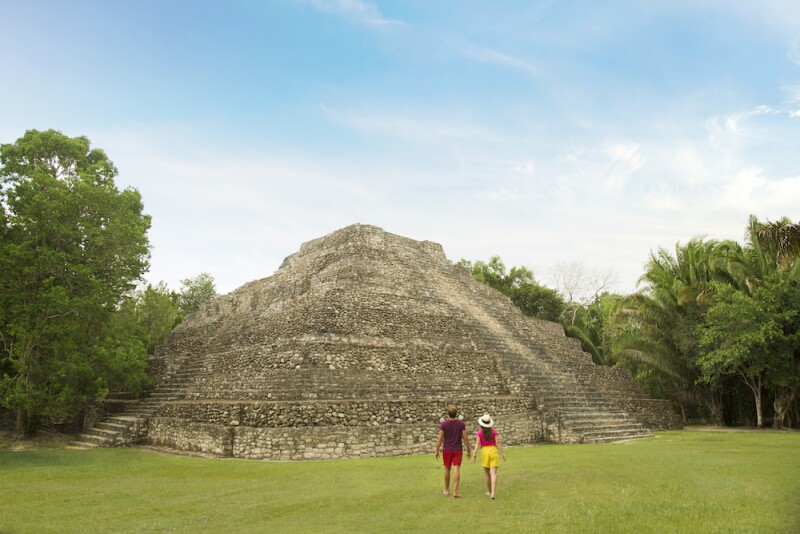While Cancun, with its white-sand beach lined with resorts and restaurants, and the towns strung along the Riviera Maya are well-known among travelers around the world, there’s another side of the country’s Caribbean—the Grand Costa Maya. Travelers who have been there tend to want to keep this region a closely guarded secret among themselves, and if you venture there too, you will likely understand why.
For many travelers to the Yucatan Peninsula, the Sian Ka’an Biosphere, to the south of Tulum, marks the end of the road. Its crystal-clear lagoons and dense rain forest appear to mark an unpassable bookend to the region. Keep on driving, however, and you’ll find the Grand Costa Maya extending down to the Belize border. Those who persevere are rewarded with an opportunity to see and experience a little-visited corner of the country. Here’s our quick overview of this surprising region:
Mahahual

The stop farthest north on the Grand Costa Maya is Mahahual, a beach town that can feel like a throwback to a Caribbean you may have assumed no longer exists. Despite its lost-in-time ambience, Mahahual is surprisingly easy to get to: The same highway that runs along the Riviera Maya continues on towards this quiet fishing village, though you’ll have to take a short detour to reach it. Once you arrive, you’ll find that what little hustle and bustle there is here is concentrated along the beach and one small road that runs parallel to it. If your ideal vacation town is the sort of place where you can spend all day in your bathing suit and flip-flops, and if an ideal evening for you consists of a stroll by the sea, alongside local families and other travelers, followed by a dinner of fish caught that day, then Mahahual fits the bill. You won’t find any resort complexes with multiple pools, instead you’ll have your choice from around three dozen small inns offering warm intimate welcomes to this little bit of paradise.
Bacalar

Head southwest from Mahahual, and you’ll arrive at Bacalar, a town that sits a little inland from the ocean. You’ll find a similar laidback atmosphere as that at Mahahual, with a few low-key bars and restaurants selling quesadillas, tacos, and Mayan dishes. At the market in the central square, you can shop for local handicrafts, especially those made with two local woods—ciricote and mahogany. As in Mahahual, the accommodations are small independent guesthouses with no big chains to be found. The main reason to travel to Bacalar, however, is its amazing natural wonder—known as the Lagoon of Seven Colors. While there are seven colors, those are all blue, with hues from turquoise to azure to sky blue. Its calm waters make it ideal for swimming and snorkeling, kayaking and paddle boarding. There is also one of the region’s famous sinkholes, or cenotes, nearby. The Blue Cenote sits on the outskirts of Bacalar and is almost as colorful as the lagoon. On dry land, the Fort of San Felipe has a Piracy Museum that covers the history of the area.
Chetumal

Continue southeast from Bacalar and you’ll reach the capital of the state of Quintana Roo, Chetumal. The Bahia Boulevard runs along the perimeter of the city, with views over the water. It’s a popular place for a sunset stroll passing many of the city’s grand buildings and monuments. Chetumal is also home to a Maya museum that provides an introduction to the region’s culture. Outside of town, this stretch of the coast is famous for its many cenotes, streams, and lagoons alongside the Hondo River—in addition to Bacalar, there are a number of smaller ones waiting to be explored. Mayan Sites

The region is known as the Grand Costa Maya for a reason. The Maya civilization stretched from Honduras and El Salvador all the way up to the northern tip of the Yucatan Peninsula. At the Grand Costa Maya you are almost in the geographic heart of the region. Chacchobén, which dates from around 200 B.C.E. and Kohunlich, from around the same period, are both just over 40 miles from Chetumal. One of the most iconic Maya structures in Quintana Roo, the Temple of the Masks, can be found at the latter site. A little farther inland, Dzibanché is home to three noteworthy temples—the Temple of the Cormorants, the Temple of the Captives, and the Temple of the Dintels. Immediately to the north of Dzibanché, Kinichná includes a remarkable three-tiered acropolis.
Whichever ancient city you choose to explore, you’ll find that the crowds are smaller here than at some Mesoamerican archaeological sites, making it much easier to live out your Indiana Jones fantasy for a day.
Learn more about the Grand Costa Maya here.











